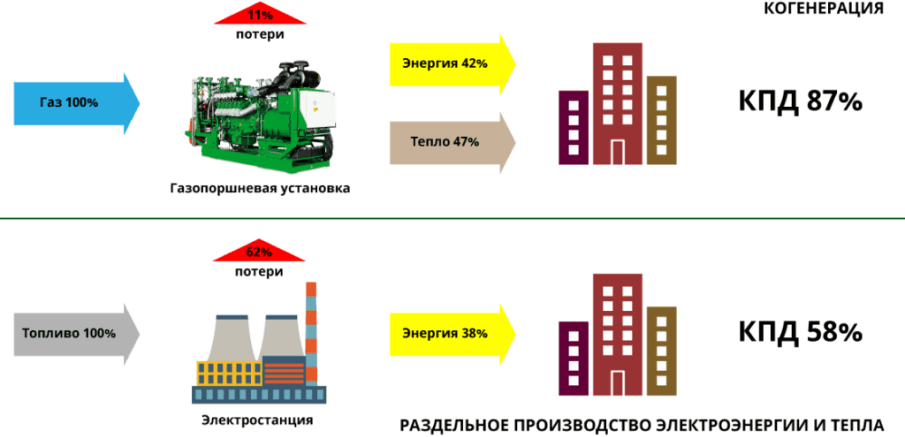Cogeneration
Cogeneration technology
Cogeneration technology is the process of combined production (generation) of thermal and electrical energy.
The last word in modern energy is the combined generation of various types of energy obtained independently from centralized energy and heat supply networks.
Technically the structure of the combined heat and power production plants (CHPP) is quite simple: it is either a gas engine genset or a gas turbine. The CHP plant is a classic internal combustion engine. The gas turbine plant consists of two main parts: a power turbine and an electric generator, which are located in one building. The high temperature gas flow acts on the blades of the power turbine and causes the turbine shaft to rotate along with the generator.
The fuel for these units is natural gas, as it is environmentally friendly and has sufficient energy intensity. However, the gas genset can also operate on other combustible gases such as propane, coke oven gas, blast furnace gas, landfill gas, biogas, hydrogen.
When choosing the type, capacity and number of cogeneration gas power plants, a number of criteria are taken into account, such as the total capacity of the power site, the range of load changes and other technological conditions. For example, with an energy consumption of less than 25 MW, it is advisable to use a gas engine genset, if the energy consumption is more than 25 MW, it is better to turn to gas turbine units.
When generating electricity in the traditional way, a huge share of side (thermal) energy is lost, which leads to an increase in the production cost. However, with cogeneration, most of the excess heat is transformed into thermal energy, which can and should be used for heating systems, hot water or process heat. Figure 1 below shows a comparison of the efficiency of both methods of electricity generation

Figure 1. Comparison of the efficiency of the use of joint and separate production of electricity and heat
We offer
To come to a balance between efficiency and reliability of the enterprise power system
Reduce capital costs
Get income from your own generation
How to implement it?
A gas genset connected to the central electrical and heat network can be a source of additional stable income. Cogeneration power plants have a great potential for operation both in Ukraine and in other countries, having their own generation, as close as possible to their consumers. The same applies to heating networks.
CHP plants have great potential for operation both in Ukraine and in countries with a similar climate. Since most of our regions are located in the northern latitudes, where the heating season is quite long, 7 or more months on average, periods without insufficient loads on cogeneration plants during the year are very short.
With proper operation, gas power plants provide economic benefits almost immediately in the form of a reduction in the cost of electricity and heat by at least 2 times.
But do not forget that in order to obtain high economic indicators, which give gas power plants, the latter must operate with a load quite close to the maximum. Thus, a decrease in energy consumption results in a decrease in the installed capacity utilization factor of the entire power center, and an increase in the produced energy cost.
What are the disadvantages of cogeneration?
The main disadvantage is the dependence of heat generation on electricity generation. In addition, in the summer period of the year, the need for heat decreases sharply, as a result, the capacity factor (thermal) of a gas mini-CHP decreases. This problem can be easily solved by supplementing the energy center based on a gas piston plant with a peak gas boiler or attaching a mini-CHP to an existing boiler house, which further simplifies the project.
Based on the above, we can conclude that it is extremely necessary to develop systems for the joint production of electricity and heat in modern Ukraine. The use of such systems, taking into account the existing monopoly tariffs, can significantly reduce the cost of consumed energy.
Gas piston units have significant resource potential, high reliability, and a wide range of power resources. The use of cogeneration plants can significantly reduce environmental pollution, which is an important advantage in a world where they strive to use environmentally friendly materials and processes.
Характеристики
- Advanced rugged frame construction
- High efficiency base load motor
- Extra large oil pan
- Automatic lubrication and cooling system
- Manufactured, tested and certified in accordance with all applicable standards
- Double support synchronous generator
- State-of-the-art two-stage fuel/air mixer
- Pressure control options
- Gas train and fuel system
- Protective devices and relays
- Heat circulation system with pumps
- Strict and comprehensive factory testing
- Exhaust system / muffler
- Ultra-low emission capability
- Thermal heat recovery and pumps
Gaseous fuel
2G gas powered power plants convert natural gas into electricity and heat on site, where needed, without losing transmission. This characteristic makes gas-fired mini CHP plants highly efficient and reliable.
A CHP plant running on natural gas achieves significant savings in primary energy and generates 60% less CO2 emissions than conventional power generators. Combustion of natural gas produced compared to other fuels results in the lowest CO2 emissions and no soot.
Natural gas is transported through an underground network, thereby saving further environmental impact from road transport.
Natural gas not only benefits the environment, but also reduces energy costs. 2G gas piston units provide the most efficient production of electrical and thermal energy and significantly reduce costs.
The heat produced is fully used for heating and hot water supply, and the electricity generated at the same time can be used in the same project, if necessary. In addition, surplus electricity is fed into the grid, which guarantees additional income and a high degree of independence from fluctuations in the energy market.
Benefits
Proven operational reliability: tens of millions of operating hours worldwide.
Ultra low emissions: up to 90% reduction in emissions can be achieved
Intelligent operation: automatically adapts to changing energy and heat densities
Proven piston engine technology: low rpm compared to extremely high axial or radial turbines with transonic speeds and increased rotation
Expected machine life by 50%: Return on investment and value for money are greatly improved by extending the life of the system.
40% fuel savings and energy efficiency: 40% more efficient than ultra low efficiency microturbines. The most durable and energy efficient gas-fired CHP plant in its class
Reliable operational excellence: thousands of installations worldwide and tens of millions of operating hours with a high percentage of uptime
Just plug and play: a ready-to-connect CHP plant carefully assembled in one module
Intelligent control system: fully integrated controls with proprietary electronic controls
Low operating costs / wear: reduced operating and maintenance costs, easy maintenance and minimal downtime
Feedback
Send your message and our manager will call you back as soon as possible

